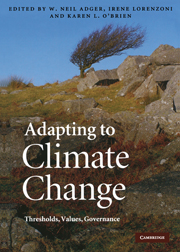Book contents
- Frontmatter
- Contents
- List of contributors
- Preface
- 1 Adaptation now
- Part I Adapting to thresholds in physical and ecological systems
- 2 Ecological limits of adaptation to climate change
- 3 Adapting to the effects of climate change on water supply reliability
- 4 Protecting London from tidal flooding: limits to engineering adaptation
- 5 Climate prediction: a limit to adaptation?
- 6 Learning to crawl: how to use seasonal climate forecasts to build adaptive capacity
- 7 Norse Greenland settlement and limits to adaptation
- 8 Sea ice change in Arctic Canada: are there limits to Inuit adaptation?
- Part II The role of values and culture in adaptation
- Part III Governance, knowledge and technologies for adaptation
- 31 Conclusions: Transforming the world
- Index
- References
2 - Ecological limits of adaptation to climate change
Published online by Cambridge University Press: 31 August 2009
- Frontmatter
- Contents
- List of contributors
- Preface
- 1 Adaptation now
- Part I Adapting to thresholds in physical and ecological systems
- 2 Ecological limits of adaptation to climate change
- 3 Adapting to the effects of climate change on water supply reliability
- 4 Protecting London from tidal flooding: limits to engineering adaptation
- 5 Climate prediction: a limit to adaptation?
- 6 Learning to crawl: how to use seasonal climate forecasts to build adaptive capacity
- 7 Norse Greenland settlement and limits to adaptation
- 8 Sea ice change in Arctic Canada: are there limits to Inuit adaptation?
- Part II The role of values and culture in adaptation
- Part III Governance, knowledge and technologies for adaptation
- 31 Conclusions: Transforming the world
- Index
- References
Summary
Introduction
The human domination of Earth's ecosystems imposes ecological limits to the ability of humanity to adapt to climate change. Humanity already uses a substantial proportion of Earth's ecosystem services, and there are limits to the extent that humanity can increase this use further, particularly in the context of climate change. There are two reasons for this: first, human modification of ecosystems is decreasing the supply and undermining the reliability of many of these services, and climatic change is likely to amplify these changes. Second, the simplification of Earth's ecosystems has reduced the ability of ecosystems to self-regulate, which increases the possibilities for abrupt changes in ecological functioning. Abrupt changes are much more difficult to adapt to than gradual changes. In this chapter, I review evidence for regime shifts in agricultural ecosystems, and discuss how climate change could alter these regime shifts. Based on these examples, I argue that adaptation policies should consider and aim to reduce the ecological limits to adaptation by focusing on building ecological resilience in combination with climate change mitigation and adaptation.
Living in the Anthropocene
Climate change is occurring on a planet that is already dominated by humans. Humanity's modification of the Earth is the product of both intentional activities, such as converting wild ecosystems to agricultural ones to increase the supply of food, and unintentional activities, such as the production of climate change via the burning of fossil fuels.
- Type
- Chapter
- Information
- Adapting to Climate ChangeThresholds, Values, Governance, pp. 25 - 41Publisher: Cambridge University PressPrint publication year: 2009
References
- 5
- Cited by



